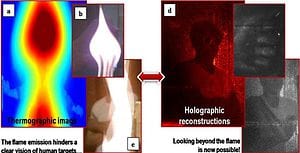
Two images of a live human subject as seen through flames. When viewed in infrared or white light, the man is almost completely occluded (left). The new system reproduces the image behind the flames using holography, revealing a man wearing a t-shirt and glasses (right). Credit: Optics Express.
I have nothing but the deepest admiration and respect for fighters – always faithful in the face of peril and always ready to put their necks on the line in order to save people from the hellish depths. As one can imagine, firefighting tech has evolved a great deal from simple fireproof clothing and a bare axe, still there is still much that can be done. One of the great challenges firefighters face is seeing through thick smoke and flames in order to reach people in need, and a recent breakthrough by a group of Italian scientists that devised an infrared digital holographic imaging system might change all that forever.
Currently, some firefighting departments employ infrared cameras and imaging systems in order to see through smoke. However, the system becomes useless if flames are in the vicinity, as the intense radiation obstructs the sensitive detectors and limit their use in the field.
“IR cameras cannot ‘see’ objects or humans behind flames because of the need for a zoom lens that concentrates the rays on the sensor to form the image,” says Pietro Ferraro of the Consiglio Nazionale delle Ricerche (CNR) Istituto Nazionale di Ottica in Italy. By eliminating the need for the zoom lens, the new technique avoids this drawback.
To tackle this issue, the Italian researchers devised an infrared camera and detector that builds a holographic image – a 3-D image of an object. To create a hologram, like the one you have on your credit card, a laser beam is split into two – an object beam and a reference beam. The object beam is shone onto the object being imaged, and it is combined with the reference beam, the interference pattern produces a 3-D image.
The difference between life and death
The holographic imaging system developed in Italy employs a beam of infrared light which is widely dispersed throughout a room. Unlike visible light, infrared isn’t blocked by smoke, but it does bounce off objects or people. The bounced off IR is then collected by a holographic imager. The information is then decoded by a computer to reveal the objects or people behind smoke or flames – all in a live 3-d scene.
In the video below you can see just how well the system works in this comparative study – on the left, imaging with simple infrared, on the right holographic imaging.
The next step researchers plan on making is to scale the system so that it may fit in firefighting gear. Also, the system could be installed as a fixed installation in buildings, tunnels and such, so that firefighters, even without the gear on hand, can be directed to the right spot. Other applications, like medical, are also viable options.
“Besides life-saving applications in fire and rescue, the potential to record dynamic scenes of a human body could have a variety of other biomedical uses including studying or monitoring breathing, cardiac beat detection and analysis, or measurement of body deformation due to various stresses during exercise,” Ferraro says. “We are excited to further develop this technology and realize its application for saving and improving human life.”
Findings were reported in a paper published in the journal Optics Express.









